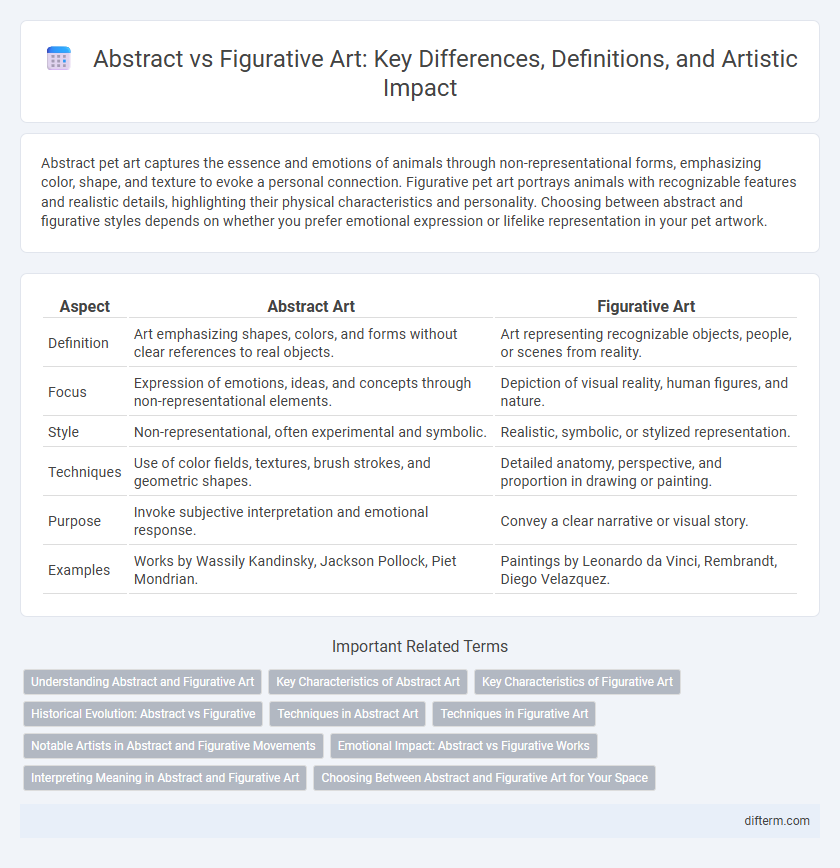Abstract pet art captures the essence and emotions of animals through non-representational forms, emphasizing color, shape, and texture to evoke a personal connection. Figurative pet art portrays animals with recognizable features and realistic details, highlighting their physical characteristics and personality. Choosing between abstract and figurative styles depends on whether you prefer emotional expression or lifelike representation in your pet artwork.
Table of Comparison
| Aspect | Abstract Art | Figurative Art |
|---|---|---|
| Definition | Art emphasizing shapes, colors, and forms without clear references to real objects. | Art representing recognizable objects, people, or scenes from reality. |
| Focus | Expression of emotions, ideas, and concepts through non-representational elements. | Depiction of visual reality, human figures, and nature. |
| Style | Non-representational, often experimental and symbolic. | Realistic, symbolic, or stylized representation. |
| Techniques | Use of color fields, textures, brush strokes, and geometric shapes. | Detailed anatomy, perspective, and proportion in drawing or painting. |
| Purpose | Invoke subjective interpretation and emotional response. | Convey a clear narrative or visual story. |
| Examples | Works by Wassily Kandinsky, Jackson Pollock, Piet Mondrian. | Paintings by Leonardo da Vinci, Rembrandt, Diego Velazquez. |
Understanding Abstract and Figurative Art
Abstract art emphasizes shapes, colors, and forms that do not represent reality directly, encouraging viewers to interpret emotions and ideas through non-literal visuals. Figurative art, by contrast, depicts recognizable subjects from the real world, such as people, animals, and landscapes, aiming for representational accuracy or expressive storytelling. Understanding the distinctions between abstract and figurative art enhances appreciation of artistic techniques, intentions, and cultural contexts across various artistic movements.
Key Characteristics of Abstract Art
Abstract art emphasizes non-representational forms, using shapes, colors, and textures to convey emotions or concepts without depicting real-world objects. It often features bold brushstrokes, dynamic compositions, and an emphasis on visual elements like line, form, and color harmony. Key characteristics include abstraction from reality, experimentation with medium, and a focus on personal or symbolic expression over literal representation.
Key Characteristics of Figurative Art
Figurative art emphasizes realistic representation of the human form, objects, and scenes, aiming to depict subjects recognizably and with accurate proportions. Key characteristics include detailed anatomy, use of perspective, and a clear narrative or emotional expression that connects viewers to the subject matter. This style often contrasts with abstract art by prioritizing visual clarity and identifiable content over stylized or non-representational forms.
Historical Evolution: Abstract vs Figurative
The historical evolution of abstract versus figurative art reflects a shift from representational forms rooted in realism to the exploration of non-representational shapes and colors, epitomized by early 20th-century movements like Cubism and Abstract Expressionism. Figurative art, dominant since the Renaissance, focused on anatomically precise human and natural forms, while abstract art rejected literal depictions to emphasize emotional expression and conceptual ideas. Key figures such as Wassily Kandinsky and Pablo Picasso catalyzed this transformation, challenging traditional perspectives and expanding the boundaries of visual language.
Techniques in Abstract Art
Abstract art techniques emphasize the use of non-representational forms, relying on color fields, geometric shapes, and dynamic brushstrokes to evoke emotion rather than depict reality. Methods such as action painting, color field painting, and collage manipulate texture and form to create immersive visual experiences without recognizable subjects. These techniques contrast figurative art's focus on realistic portrayal, allowing abstract artists to explore pure expression through innovative material and compositional approaches.
Techniques in Figurative Art
Figurative art techniques emphasize realistic representation through precise use of anatomy, perspective, and shading to capture human form and emotions. Artists employ methods like chiaroscuro for depth, contour drawing for structure, and glazing to build rich, lifelike textures. These approaches contrast with abstract art by focusing on recognizable subjects and narrative clarity.
Notable Artists in Abstract and Figurative Movements
Wassily Kandinsky and Piet Mondrian stand out as pivotal figures in the Abstract movement, pioneering non-representational art that emphasizes color and form over realistic depiction. In the Figurative tradition, artists like Lucian Freud and Alice Neel are renowned for their expressive portrayals of the human figure, blending emotional depth with meticulous detail. These artists collectively shaped the evolution of 20th-century art, defining the distinct paths of abstraction and figuration.
Emotional Impact: Abstract vs Figurative Works
Abstract art evokes emotional responses through color, form, and texture, allowing viewers to interpret feelings uniquely and personally. Figurative works communicate emotions more directly by depicting recognizable subjects and human expressions, fostering immediate empathy and connection. Both styles harness visual elements to provoke emotional engagement, yet abstract art emphasizes subjective interpretation while figurative art relies on narrative clarity.
Interpreting Meaning in Abstract and Figurative Art
Interpreting meaning in abstract art relies on recognizing shapes, colors, and forms that evoke emotions and ideas without representing specific objects. Figurative art conveys meaning through recognizable subjects such as people, animals, and objects, allowing viewers to connect directly with the depicted scene. The interpretation of abstract art is subjective and open-ended, while figurative art often provides a clearer narrative or symbolism tied to real-world references.
Choosing Between Abstract and Figurative Art for Your Space
Choosing between abstract and figurative art for your space depends on the desired atmosphere and emotional impact. Abstract art enhances modern interiors with its emphasis on color, form, and texture, inviting subjective interpretation and creative engagement. Figurative art, featuring recognizable subjects like portraits or landscapes, adds narrative depth and emotional connection, complementing traditional or eclectic decor styles.
Abstract vs Figurative Infographic

 difterm.com
difterm.com